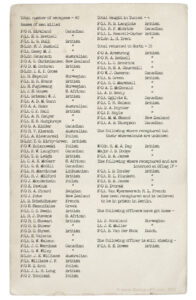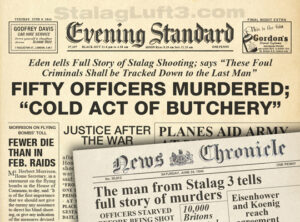Forgotten Friday – The Great Escape
In this week #ForgottenFriday we are delving into the history of the Great Escape! 78 years ago today!
On March 24 1944, one of the most audacious projects carried out during WW2 occurred. It was the mass escape of Allied soldiers from the German prisoner of war camp Stalag Luft III, the story of which was forever immortalised in the 1963 film The Great Escape, starring Steve McQueen.
Although the mass escape, which was the largest attempted during WW2, had nothing to do with daring motorcycle jumps over barbed wire fences, the true story is just as dramatic, as hundreds of men put their lives on the line to not only enjoy the taste of freedom once again but to also demonstrate their will to resist Hitler’s tyranny.
Stalag Luft III was a German POW camp situated deep within Nazi-occupied Poland, some 100 miles southeast of Berlin. The camp held thousands of captured Allied airmen during WW2 and was considered one of the hardest to escape from. Three design features made tunnelling almost impossible – the loose collapsible sandy soil upon which the camp was built, elevated prisoner housing to expose tunnels and the placement of seismograph microphones around the perimeter of the camp. None of that was to deter RAF Squadron Leader Roger Bushell, who conceived the plan for the mass escape in the spring of 1943.
Less than two weeks after its opening, F/Lt Raymond Keen of the RAF’s 78 Bomber Squadron arrived in the North Compound of Stalag Luft III. His aircraft, a Halifax II (W7931), had been shot down following a night-time raid on Duisburg. After having spent the previous few days being interrogated at Dulag-Luft, a transit camp for captured airmen run by the Luftwaffe, the welcome he received in Stalag Luft III was not quite what he was expecting. Once more he found himself grilled, though this time by a select group of existing POWs. Furthermore, these same men seemed to take more than a passing interest in his movements there.
After dark, the would-be escapees collected along with others involved in Hut 104. Between them, they had around 400 sets of forged papers, civilian clothes, maps, compasses, ‘iron rations’ (a kind of homemade fudge cake), plus a variety of other gadgets. A hostile country blanketed in deep snow awaited them at the far end of the tunnel. F/Lt Keen watched as events unfolded, sketching out the words of a poem to pass the time.
Around 10 p.m. the lead tunneler, F/Lt Johnny Bull, hewed out the last few inches of earth to reach the surface. A gut-wrenching sight awaited him. The team’s calculations had fallen some feet short, and instead of emerging within the relative safety of the woods, they came up in open ground just beyond the perimeter of the compound and perilously close to a sentry box.
One by one, they descended the shaft and boarded the trolleys to begin their journey to freedom. The first two out were F/Lt Johnny Marshall and Bull. They took with them a rope which reached back into the tunnel and provided a simple means of communication. Bushell and his traveling partner, French pilot LT Bernard Scheidhauer, passed through the tunnel early and took off into the night.
Suddenly, at around midnight, the air raid sirens began to drone, and the camp fell into a blackout as Allied aircraft were detected over the region. For those in Hut 104, the timing could not have been worse. With the loss of electricity, the tunnel was plunged into total darkness. A period of confusion ensued. Further hindering matters, guard patrols were doubled. It wasn’t long until the huts shuddered with the distant impacts of falling bombs as the aircraft eventually reached their target, Berlin. It is a sober testimony to the destructive forces unleashed by such raids that they could be felt over 100 miles away.
At 2 a.m. the blackout was finally lifted, and the camp’s electricity was restored. Over the next few hours, progress continued, though with the various delays, the number so far to have escaped was considerably less than expected. As dawn began to break the controllers in Hut 104 decided it was time to call a halt and dispatched the last three men down the tunnel. 87 men had now made that descent. Meanwhile, up above in the cold, early light, a perimeter guard happened to stray from the regular path and passed right beside the exit hole. At that very moment, confusion with the signals leads to an escapee emerging right behind the sentry. The guard then spotted the trail that had been carved in the snow and followed it back to the man on the ground. At this point, the controller in the woods sprang forth with his hands in the air, attempting to distract the guard. Sounding the alarm with a cry, the sentry fired a warning shot in his direction.
The breakout had been discovered. Those few men left in the tunnel beat a hasty retreat into Hut 104. They immediately set about destroying all evidence they had of involvement in the escape, committing them to ashes in the stove. Outside all hell broke loose. Guards were dashing around with guns in hand, ready to shoot anything that moved. In a state of complete meltdown, the Kommandant was heard to threaten to personally shoot two British officers if there was any further provocation.
The Germans began a thorough search of each hut attempting to discover the source of the tunnel. Fortunately for those in Hut 104, they wound up being one of the last in the queue and had sufficient time to erase all evidence and return the environment to something resembling normality. Once the guards had searched to hut to no avail, the Germans pleaded with the adjutant S/L Bill Jennens to disclose the tunnel’s entrance as one of the guards had become trapped in its depth. With the tunnel having served its purpose, Jennens gave up the location, and the stove was removed to reveal the hapless guard, Unteroffizier Charlie Pilz.
The four men who were captured outside the tunnel were immediately sent to the camp’s stockade, known as the cooler. Years later, this isolation block would be enshrined in movie history through Steve McQueen’s character, The Cooler King, in The Great Escape. In the days that followed, others would find themselves guests of the block as the piqued Germans clamped down over the slightest infringement.
A nationwide alert was declared with all forces, from the Gestapo through to the local police, tasked to locate the men. Of the eighty-seven men who had braved the tunnel that night, four were recaptured immediately outside the compound, and another seven had retreated into Hut 104. Over the coming days, all but three of those who escaped were recaptured, beaten down by the extreme cold and challenges of finding themselves adrift in enemy territory. A number of those with forged papers had intended to make swift headway by rail, but in the darkness, many had struggled to find the local station. Some simply pointed their compasses toward the nearest neutral country and began a futile trek through the frozen wastes. In the confusion of the night and the days that followed, there was some uncertainty over the actual number who had escaped.
On the morning of 6 April, Massey was summoned before the new Kommandant. Through an interpreter, the German Officer conveyed the somber news that forty-one of those involved in the break-out had been “shot while trying to escape.” When repeatedly pressed by the shocked Massey on how many of the escapees had only been wounded, Braune reluctantly confirmed, “None.”

The revelation was greeted with dismay and disbelief by those in the North Compound. A few days later, a list with more names were added to the roll call of the dead. However, many in the camp believed the reports to be false, a scenario manufactured by the Germans to deter any further escape attempts. And indeed, certain actions by the authorities did lend credence to that belief, such as shipping out the possessions of the fifty men which give the impression that they were simply being held elsewhere.
It was only after the urns containing the actual remains of the fifty men arrived at the camp two weeks later that all lingering doubts were dispelled. The full story of the fate that befell the men eventually came to light. Hitler and the high command had first heard news of the escape while attending a conference at Berchtesgaden. Enraged, the Führer immediately demanded that all the escaped POWs should be executed once captured, though, with counselling from Göring and others, the number was finally revised down to fifty.[1]

The POWs were in due course allowed to construct a stone memorial to house the remains of ‘The Fifty’. It still stands to this day not far from the clearing in the woods that was once Stalag Luft III.
Read more by clicking the reference below!

